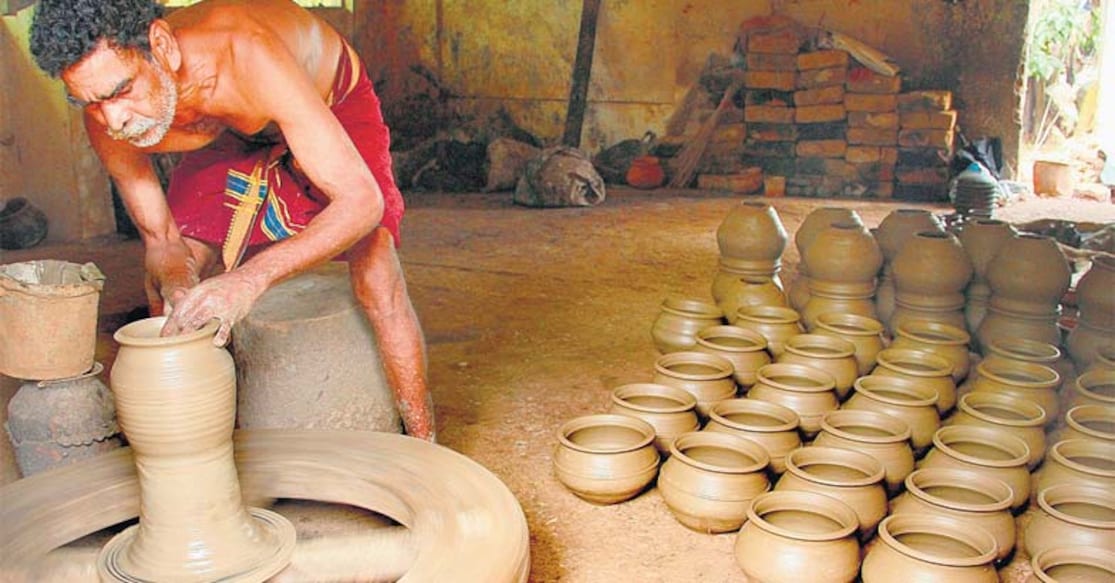Pottery: A hereditary occupation gathering soot

Mail This Article
There was a time when their hearths burned only when those of the public did. But as times changed many potter families plunged into the abysses of poverty. Many an earthen pot gave way to non-stick utensils. However even though the earthen pot has returned to fashion thanks to tourism, those engaged in earthen pot making are facing several issues including lack of availability of raw materials. Members of the Kumbharan (Kumbhari) community who have made pottery their hereditary occupation are immigrants from Andhra Pradesh. They communicate via a script-less form of Telugu. These people who migrated to various states from Andhra Pradesh talk in a hybrid tongue that combines Telugu with the respective state’s language. Those who reached Wayanad district were immigrants from Palakkad. At first only a few families came over but later the influx became heavier. They had arrived here at a time when only earthenware was in use. Pottery was the sole occupation of the visitors in those days. But when the earthen pots gave way, their lives began to be in the doldrums. The younger generation in the family went seeking better job prospects. However the ones who dearly love their hereditary occupation have engaged in this vocation then and they do that now. They do so in the hope that one day their vocation will regain its lost glory. **Hopes a glitter** The time has come when their hopes have begun to take wings. As people who grew fed up of the taste of food made in metal plates realized the worth of earthenware, the market for the latter has shifted from vessels kept for roadside hawking to exclusive shops in shopping malls. It was soothing to the mind as well. Earthen pots have reappeared in homes as if in remembrance of the good old days. In most of the big hotels, serving food in earthenware has become the norm. Although all these give cause for hope, the fate of the potters is still in a crisis. **Crisis overcome** Clay, the main raw material in earthen ware making, is becoming unavailable by the day. Even if it is available, there are many procedures to be undergone from digging it up to attaining a usable stage, all of which lead to constant price hikes. Clay brought home after paying a heavy price and traversing huge distances tend to get dearer. Also needing to be borne are the losses incurred due to breakage of the clay which is later painstakingly molded to shape and made market-ready. **Birth of an earthen pot** Clay is sliced; stones and granules removed, stamped and brought to pulp form. The clay obtained show of even a single granule is cast in the mud wheel. Artistry and swiftness of hand act on the clay emerging from the wheel give shape to various types of clay vessels. This vessel form which is bottomless when removed from the wheel is beat into vessels using wood. These are later dried and a yellow mud added and calcinations done for coloration. Later these are dabbed with grass and mud and stacked in kiln and fired to bake for three to four days. The earthen pot takes shape as it is wiped and final polishes are done. **Marketing** People selling earthenware in baskets door to door is a common sight even today. However they also say that orders from big resorts and hotels come seeking them nowadays. **Benefits of earthenware** Nature Cure experts say that the benefits of eating food cooked in earthenware are untold. Old timers vouch for the ability of earthenware to absorb the toxins contained in the food items including vegetables that we consume. They also attest to the fact that the body’s allergies, aches, hair loss, etc mostly arise from eating food cooked in aluminum vessels and that risk of such ailments can be drastically reduced by using earthenware. **New marketing strategies** The earthenware has changed for those who succeed in the markets in other rat races. Vessels fitted with beads and figures for decoration have been introduced in the market. Vessels costing from two digit figure to thousands of rupees have reached the market. Artistry has given shape to several types of vessels. All pots and pans required for a kitchen, various articles for the flower garden, Tandoori hearth, flower vase, water pot, aids for raising birds, etc belong to them. Attendees at the training in various artworks and finishing intended for those seeking novelty conducted at ITC Thalipparamb are also among them. **Tradition should be preserved** These people fear the dying out of their hereditary occupation. The main reason of course is that the new generation is not taking to the trade. They cite the low income and the difficulties arising from lack of other sources of income during the time taken to study it as reasons. If the government shows some benevolence via granting of aid, this can be developed into a massive enterprise generating many jobs.

